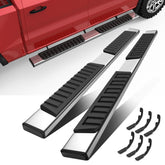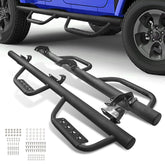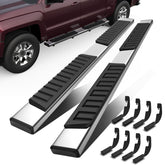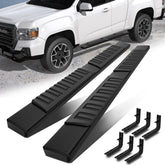Do you have to drill holes for running boards?
When considering the installation of running boards on your vehicle, a common question arises: Do you have to drill holes for running boards? This query often reflects the desire to enhance a vehicle's functionality and aesthetics without permanently altering its structure. The answer, however, depends on various factors, including the type of vehicle, the running board design, and personal preferences. Let's delve into this topic to explore the options available for installing running boards with and without drilling holes, ensuring a seamless and informed decision for your vehicle upgrade.

Installation Methods: Overview and Comparison
Running boards can be installed using different techniques, primarily categorized into drilling and no-drill methods.
Pros and Cons of Different Installation Techniques
The two main installation methods have distinct pros and cons:
Drilling Holes for Running Boards
Drilling holes involves securely attaching the running boards to the vehicle's frame or body by drilling holes into the vehicle's underside. This method provides enhanced stability and durability, making it suitable for heavy-duty applications. It allows for more customization options in terms of running board placement. However, drilling holes can cause damage to the vehicle's body, leading to rust or structural issues if not done correctly. The installation process can be more complex and time-consuming, requiring professional expertise.
No-Drill Installation Methods
No-drill installation methods, such as clamp-on running boards, utilize brackets or clamps that attach to the vehicle's existing frame or rocker panels without drilling. Many vehicle owners prefer this method due to its simplicity and the lack of permanent alterations to the car.
No-drill methods may not be as stable or durable as drilling methods, especially for heavy-duty usage. They may need more compatibility with specific vehicle models and can sometimes look less integrated compared to drilled installations.
Benefits of Drilling Holes
Drilling holes for running board installation offers several distinct advantages:
- Enhanced Stability and Durability: Running boards securely bolted to the vehicle's frame or body provide superior stability, especially under heavy loads or rugged driving conditions.
- Customization Options:Drilling allows for precise placement of the running boards, accommodating specific preferences for style and functionality. This customization can be particularly beneficial for off-road vehicles or trucks used for towing.
Drawbacks of Drilling Holes
Despite its benefits, drilling holes for running boards has some potential drawbacks:
- Potential Damage to the Vehicle's Body:Improper drilling techniques or corrosion over time can lead to structural damage or rust on the vehicle's body, compromising its integrity.
- Complications During Installation: Drilling requires specialized tools and skills, making the installation process more complex and time-consuming than no-drill methods.
Advantages of No-Drill Installation Methods
No-drill installation methods have become increasingly popular due to several advantages:
- Simplicity and Accessibility:No-drill methods are generally more straightforward and quicker to implement, making them suitable for DIY enthusiasts or those seeking a hassle-free installation.
- Preservation of Vehicle Integrity:By avoiding drilling, these methods minimize the risk of damaging the vehicle's body or frame, preserving its structural integrity and resale value.

Professional Installation vs. DIY
The choice between professional installation and DIY largely depends on one's comfort level with vehicle modifications, as well as the complexity of the installation method.
Cost Considerations for Each Approach
Professional installation typically involves higher costs due to labor charges and expertise. However, it ensures proper installation and may come with warranties or guarantees.
DIY installation can be more cost-effective but requires access to tools and technical knowledge. DIYers should be aware of potential risks, such as improper installation, safety issues, or vehicle damage.
Alternative Installation Options
Clamp-on running boards offer a viable solution for those seeking drilling alternatives. These boards use adjustable brackets or clamps to secure the boards to the vehicle's rocker panels or frame without requiring any drilling.
Compatibility and Limitations of Clamp-On Boards
Clamp-on running boards are versatile and compatible with various vehicle models. However, they may provide a different level of stability or durability than drilled installations, particularly for heavy-duty applications.
Advancements in Installation Technology
Future trends in running board installation include innovations such as:
- Improved Mounting Systems: Manufacturers are developing advanced mounting systems that offer the stability of drilled installations with the ease of no-drill methods.
- Integrated Designs: Running boards are integrated more seamlessly into vehicle designs, offering aesthetic appeal and functionality.
- Materials Innovation: Using lightweight yet durable materials, such as aluminum alloys or composite plastics, is becoming more prevalent, reducing installation complexity while maintaining durability.
Installing running boards involves carefully considering various factors, from vehicle compatibility to installation methods. While drilling holes for running board installation provides enhanced stability and customization options, it has potential drawbacks, such as vehicle body damage and installation complexity. No-drill alternatives like clamp-on running boards offer simplicity and accessibility but may not be suitable for all vehicle types or usage scenarios.
Featured Products
- $198.99
- $198.99
- Unit price
- / per
- $198.99
- $198.99
- Unit price
- / per
- $203.99
$203.39- $203.99
- Unit price
- / per
- $198.99
- $198.99
- Unit price
- / per














